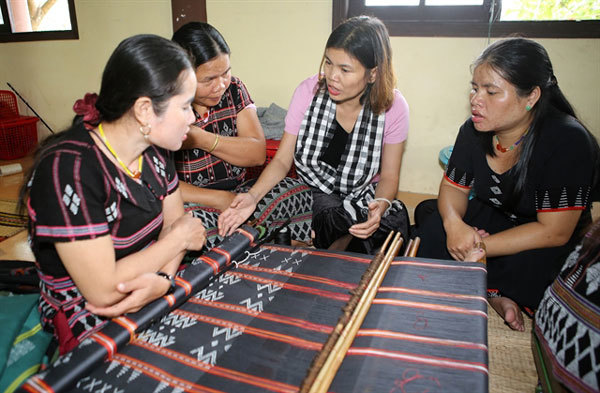 |
| A group of ethnic minority women in the mountainous district A Luoi in the central province of Thua Thien-Hue receive training on making brocade products commercially, as part of a programme by Vietnam Rural Industries Research and Development Institute and USAID aiming to promote sustainable development in the area. VNA/VNS Photo Ho Cau |
This places Vietnam among the group of countries with the highest HDI growth rates in the world.
This is one of the key finding of the 2019 Human Development Report, released on Monday by the United Nations Development Programme (UNDP) entitled “Beyond income, beyond averages, beyond today: Inequalities in human development in the 21st Century.”
Addressing the report launch in Hanoi, UNDP Resident Representative Caitlin Wiesen said the 2019 Human Development Report disclosed the next generation of inequalities emerging around digital technology, education, and the climate crisis and proposes new ways of measuring and approaching inequalities.
Wiesen praised Vietnam for having firmly embarked on people-centered development and equality in its current socio-economic development strategies and plans.
“Vietnam’s significant Human Development progress since 1990 has been achieved with relatively low increases in inequality,” she said.
“Taking into account the Inequality Adjusted HDI, Vietnam is eight places higher than its HDI ranking in 2018.”
“Vietnam is at a critical juncture as it designs its next Socio-Economic Development Strategy, with decisions made today determining whether the country will continue its current pattern of growth with relatively low inequality or whether new forms of emerging inequalities will be further entrenched and deepened with unsustainable growth pathways.”
According to the report, Vietnam’s 2018 HDI of 0.693 is above the average of 0.634 for countries in the Medium Human Development group.
Vietnam ranks 118th out of 189 countries, and needs only an additional 0.007 points to join the High Human Development group. Vietnam’s HDI rank in 2018 is higher than India’s, Lao PDR, Myanmar and Cambodia.
Meanwhile, Vietnam’s loss of HDI value due to inequality in 2018 is 16.3 per cent, its loss of income due to inequality is 18.1 per cent and, its GINI coefficient – a statistical measure of economic inequality in a population – at 35.3 – are among the lowest in the East Asia and Pacific region.
Vietnam has also been performing well in terms of gender equality. The Gender Development Index value of 1.003 puts the country in the top five groups of 166 countries in the world, with Vietnam ranking 68th out of 162 countries in Gender Inequality Index. Particularly commendable is the share of seats in parliament which places Vietnam among the top third of countries globally.
However, Caitlin said, there were important areas for improvement. Vietnam ranks among the bottom third of countries globally in terms of sex ratio at birth (1.12), violence against women by non-intimate partners (34.4 per cent) and women with accounts in financial institutions or with mobile money service provider (30.4 per cent).
Although Vietnam’s forest coverage as among the top third of countries globally, the country is among the bottom third of countries in terms of carbon emission per capita.
Addressing these would be a key challenge to ensure the sustainability of Vietnam’s growth, she said.
Caitlin suggested that Vietnam should raise people’s awareness on sex-selection issue.
“If it is not addressed, they will create lots of destruction for Vietnam in the future,” she told Việt Nam News.
Nguyen Tien Phong, Assistant Resident Representative of UNDP, said regarding to socio-economic sustainability, a lot of jobs generated by small and medium enterprises did not require skills, meaning Vietnam ranks low in skilled labour force and vulnerable employment.
Vu Dai Thang, Vice Minister of Ministry of Planning and Investment said Vietnam has issued an action plan on the implementation of the 2030 Agenda for sustainable development.
The Vietnamese Government’s determination was represented by the Nation Assembly's approval of the master plan on socio-economic development for ethnic minority people with the goal of ensure equality in human development. It was in accordance with the spirit “Don’t leave any one behind” upheld by the government, he said. — VNS

Vietnam’s population to reach 104 million by 2030
The Vietnam’s population is projected to reach 104 million by 2030 according to the Vietnam Population Strategy recently approved by the Prime Minister.

Vietnam hard-pressed to maintain high human capital index in long term
Even though the human capital index (HCI) of Vietnam exceeds the global, regional, and even upper-middle-income country averages, Vietnam still faces challenges in ensuring high-quality human resources.
 Vietnam has made good progress in human development, with an average annual Human Development Index (HDI) growth of 1.36 per cent during the 1990-2018 period.
Vietnam has made good progress in human development, with an average annual Human Development Index (HDI) growth of 1.36 per cent during the 1990-2018 period.